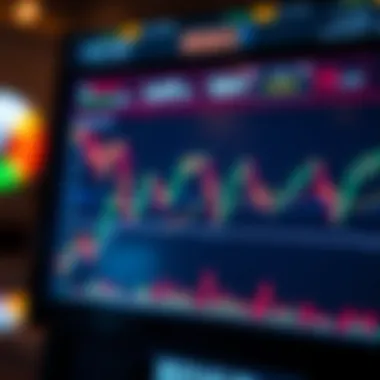Currency Trading Insights in the Digital Era


Intro
The realm of currency trading has evolved dramatically, especially with the emergence of digital currencies and cryptocurrency exchanges. As conventional finance grapples with digital innovations, the trading dynamics have shifted towards a more decentralized framework. This transformation is not just about technology; it encompasses various aspects ranging from market behaviors to regulatory frameworks.
In the digital age, currency trading is no longer confined to the walls of traditional financial institutions. Today, individuals can engage in trading from anywhere around the globe, thanks to the proliferation of cryptocurrencies and online trading platforms. This shift has democratized access to financial markets, allowing anyone with an internet connection to delve into currency trading.
Throughout this article, we will dig into the key components of currency trading, especially focusing on how digital currencies reshape the trading landscape. We will cover market analysis, investment strategies, and the inherent risks, with the aim of equipping readers with insights that promote informed decision-making in this complex arena.
Prelims to Currency Trading
Currency trading, often referred to as foreign exchange trading or forex trading, entails the buying and selling of currencies in the global marketplace. This topic garners substantial interest due to its integral role in modern economics, financial systems, and the increasing prominence of digital currencies. Understanding currency trading is crucial for investors, analysts, and traders who seek to navigate the complexities of markets that are often shrouded in rapid fluctuations and technological advancements.
In an age where transactions cross borders in a blink, grasping the mechanics of currency trading provides a competitive edge. The primary benefit lies in the potential for profit from market volatility, as the value of currencies can shift dramatically based on myriad factors such as economic indicators, geopolitical events, and market sentiment. Moreover, with the rise of digital currencies and platforms, it has become easier than ever for common investors to partake in this trade, democratizing access that was once limited to banks and large institutions.
However, it's also essential to consider the inherent risks associated with currency trading. Market volatility can lead to significant financial losses, while challenges such as regulatory oversight and cybersecurity threats can impact trading operations. As the landscape continues to evolve, staying informed about the latest trends and strategies becomes paramount.
As we navigate through this article, we will dissect the fundamental aspects of currency trading. From historical context to the mechanics and practices today, the aim is to provide a detailed understanding that equips readers with the knowledge to make informed decisions in their trading endeavors.
Defining Currency Trading
Currency trading involves the exchange of one currency for another, operating on the principle of supply and demand in international markets. For example, when you exchange U.S. dollars for euros, you are participating in a forex transaction. The objective is to capitalize on changes in currency values, leading to potential gains or losses based on fluctuations in exchange rates. This process may seem straightforward, yet multiple factors influence how these rates are determined.
The global forex market is notable for its size and liquidity, with trillions of dollars traded daily. As a decentralized market, it operates 24 hours a day, providing opportunities for traders across different time zones. Currency pairs, such as EUR/USD or GBP/JPY, represent the relationship between two currencies, allowing traders to speculate on their relative performance.
Historical Perspective of Currency Trading
Currency trading has a rich history that predates modern financial systems. In ancient times, barter systems were predominant, where goods were exchanged directly. As societies grew and trade expanded, gold and silver emerged as common mediums of exchange, laying the groundwork for the concepts of currency and value.
The formal establishment of exchange markets began in the 17th century, with the creation of financial institutions that sought to facilitate currency conversion. The rise of the gold standard in the 19th century provided a stable basis for valuing currencies, although its abandonment during the 20th century led to the floating exchange rate system we observe today.
The evolution of technology has transformed currency trading dramatically. The introduction of electronic trading platforms in the late 20th century made it accessible to individual traders, which, coupled with globalization, has prompted a more interconnected and fast-paced trading environment. Today, with cryptocurrencies entering the fray, the dialogue on currency trading continues to evolve, promising new opportunities and challenges for investors.
The Mechanics of Currency Trading
In the vast ocean of financial markets, currency trading serves as the backbone that keeps the wheels of global commerce turning. An understanding of the mechanics behind this trading not only enriches one's grasp of finance but also sheds light on the values of global economies. The intricacies involved in executing trade, the significance of currency pairs, and the various influences on exchange rates are areas fundamental to creating informed strategies and decisions.
How Currency Trading Works
Currency trading operates through the buying and selling of currency pairs. A trader examines economic indicators, market trends, and geopolitical factors, and makes decisions based on the interplay of supply and demand. In simple terms, when a trader expects a specific currency to strengthen against another, they buy that currency and sell the counterpart. If the trader's predictions align with market movements, they profit.
The execution of trades usually happens on platforms provided by brokers that function as intermediaries. Leveraging technology, these platforms allow real-time trading as well as the option to engage in automated trading through algorithms and bots. This can be advantageous, especially when reactions to market changes can happen in the blink of an eye.
Understanding Currency Pairs
In the realm of currency trading, pairs are crucial, being the basic units of exchange. A currency pair consists of two currencies: the base currency and the quote currency. For instance, in the EUR/USD pair, the Euro is the base, while the US Dollar is the quote currency. This pair indicates how much of the quote currency is needed to purchase one unit of the base currency.
- Major Pairs: These include widely traded pairs like EUR/USD, USD/JPY, or GBP/USD. Their high liquidity often results in narrower spreads, making them an attractive option for traders.
- Minor Pairs: These involve less common currencies and usually exhibit volatility, which can be favorable or unfavorable depending on the trader’s strategy.
- Exotic Pairs: These consist of one major currency coupled with a currency from a developing economy. High risk and high reward characterize this bracket, appealing to seasoned traders looking for unique opportunities.
Exchange Rates and Market Influences
Exchange rates are like a compass for traders, guiding decisions and strategies. They represent the value of one currency in relation to another, influenced by a myriad of factors. Understanding these influences is essential for predicting market behavior.
- Interest Rates: Central banks define interest rates, and changes often lead to shifts in currency values. For example, an increase in the interest rate of a currency typically enhances its attractiveness to investors seeking higher returns.
- Economic Indicators: Key metrics such as GDP growth, employment figures, and inflation rates play a significant role in shaping expectations about a currency's future performance.
- Political Stability: A country with a stable government tends to attract foreign investment, leading to an appreciation of its currency, while political instability often results in depreciation.
"Currency trading is not just about numbers; it’s also about understanding the stories behind those numbers. Each trade tells a tale of economic relationships and human behavior."
With all these elements interlinking, traders can navigate the complex world of currency markets with greater acuity. As they advance, knowing how these mechanics interact will empower them to formulate robust trading strategies that adapt to market fluctuations.


Types of Trading in Currency Markets
In the intricate domain of currency trading, understanding the various types of trading is crucial. Each trading style comes with its nuances, benefits, and considerations that can sway an investor's decisions. Comprehending these differences helps traders, investors, analysts, and tech enthusiasts tailor strategies to meet their specific goals. This section will explore three primary types of trading: Spot Trading, Forward and Futures Trading, and Options Trading, each uniquely serving the diverse needs of market participants.
Spot Trading
Spot trading is perhaps the most straightforward form of trading available in the currency markets. Here, currencies are bought and sold for immediate delivery, with transactions settled on the spot, usually within two business days. The appeal of spot trading lies in its simplicity and the immediacy of its nature. Traders can swiftly enter and exit positions, reacting to market changes in real-time. This characteristic makes spot trading particularly attractive for those who enjoy fast-paced environments or seek to capitalize on short-term price movements.
In spot trading, understanding market prices, also known as spot prices, becomes crucial. These prices fluctuate due to multiple factors such as economic news, geopolitical events, and overall market sentiment. Moreover, traders often utilize technical analysis to forecast potential price movements, employing charts and indicators to assist in decision-making.
Key Features of Spot Trading:
- Immediate transactions: Brought into play when a trader wants to act on a perceived market trend.
- Instant settlement: No lengthy waiting periods; traders see swift changes.
- Liquidity focus: Spot markets often have higher liquidity, providing opportunities to execute large trades with minimal impact on prices.
Forward and Futures Trading
Forward and futures trading are essential for investors desiring the ability to hedge risks or speculate on future price movements. These are designed for transactions that will occur at a specified future date, offering a layer of strategic depth often missing in spot trading.
In both cases, contracts are established at predetermined prices, thus insulating the participants from market volatility during the contract's duration. However, the key difference lies in their execution and regulation: Futures contracts are standardized and typically traded on exchanges, while forward contracts are customizable agreements negotiated directly between two parties.
Advantages of Forward and Futures Trading:
- Risk Management: Ideal for companies or investors looking to lock in prices and reduce their exposure to sudden market shifts.
- Leverage Opportunities: Futures allow traders to control a more substantial position with a smaller amount of capital, increasing potential profits (or losses).
This type of trading is not without challenges, however; the complex nature, regulatory requirements, and margin risks can be daunting for new traders.
Options Trading
Options trading offers a different dimension to currency trading, providing traders with the right, but not the obligation, to buy or sell currencies at a specified price before a particular expiration date. Therein lies its flexibility. Options can be utilized for hedging against potential losses or speculating on price movements. This allows for strategic plays, like buying options when anticipating market volatility.
With options, traders can adopt various strategies ranging from simple calls and puts to more complex combinations like straddles and spreads, which can produce diverse risk/reward outcomes. The intricacies can sometimes make options trading seem more complex, but it also gives traders a broader toolkit for maneuvering through the volatile currency landscape.
Notable Benefits of Options Trading:
- Limited risk exposure: The maximum loss is limited to the premium paid for the option, offering a safety net for speculators.
- Diverse strategies: Can be customized to suit various market conditions, allowing traders to take advantages of different scenarios.
Options trading might appear intimidating to the uninitiated, but for strategic thinkers, it opens many doors in the currency markets.
As the trading world continues to evolve, a solid understanding of the different types of trading becomes essential for anyone aiming to navigate the real-time complexities of currency trading.
For further exploration of trading mechanisms, consult resources such as Investopedia for detailed insights on spot and options trading, or Wikipedia for an overview of futures trading.
Digital Currency Trading and Its Evolution
Digital currency trading represents a revolutionary shift in how financial exchanges occur. In a world where technology evolves faster than one can say "blockchain," understanding this evolution becomes crucial. As traditional currency trading established rules over decades, the emergence of digital currencies has challenged and reshaped these norms, offering both opportunities and obstacles. Investors and traders now must navigate this uncharted terrain where familiar rules often do not apply, making it a ripe topic for exploration.
As cryptocurrency exchanges continue to gain traction, they're redefining the trading landscape. Unlike traditional stock markets, cryptocurrency exchanges articulate a decentralized approach, facilitating peer-to-peer trading without intermediaries. This aspect exponentially enhances accessibility and efficiency for users globally.
Moreover, the flexibility of digital assets introduces benefits that traditional currencies or commodities cannot match. Transactions can occur 24/7, crossing geographical boundaries almost instantly while often incurring lower fees. However, navigating this landscape isn't without its considerations. The lack of centralized authority raises questions around security, and regulatory frameworks are still catching up.
"As the saying goes, 'With great power comes great responsibility.' The power of cryptocurrencies lies in their disruptive capabilities and evolution, yet traders must understand the inherent risks."
Investors today must stay sharp and agile, as digital currency trading consistently introduces new tools and mechanisms. This makes knowledge and continuous learning not just advisable but essential. Understanding the nuances of trading platforms, figuring out how market trends play out in real-time, and making sense of what's behind the price swings can mean the difference between profit and loss. Additionally, with various factors pulling the strings—like government policies, emerging technologies, and market sentiment—the digital currency trading scene remains dynamic.
Overview of Cryptocurrency Exchanges
Cryptocurrency exchanges are platforms where users can buy, sell, or exchange cryptocurrencies for other digital currency or traditional currency. They play a pivotal role in the ecosystem of digital currencies. Generally, these exchanges can be categorized as centralized and decentralized. Centralized exchanges, such as Coinbase, serve as intermediaries, making it convenient to trade and offering a user-friendly experience. This setup usually provides liquidity and is best for those new to crypto trading. In contrast, decentralized exchanges like Uniswap allow users to trade directly without the need for a trusted third party, emphasizing privacy and control.
When considering a cryptocurrency exchange, these factors are essential:


- Security Features: Look for exchanges with a strong track record of security measures, including two-factor authentication and cold storage options.
- User Interface: A streamlined interface can make the world of trading more accessible, particularly if you're just starting.
- Liquidity: A platform with high trading volume often means better prices and quicker transactions.
The bustling nature of these exchanges underscores how digital currencies have transformed the way investors think about assets. Gone are the days when options were limited to conventional investments like stocks and bonds. Now, with a myriad of trading pairs and coins available, anyone with an internet connection can dive into the market.
The Role of Blockchain Technology
Central to the conversation of digital currency trading is blockchain technology. This innovative framework serves as the backbone for the vast majority of cryptocurrencies. It acts like a public ledger, recording all transactions in a way that is nearly impossible to alter once confirmed. This characteristic not only enhances trust among users but also provides transparency, a vital element for any trading activity.
Blockchain technology offers distinct benefits:
- Traceability: Every transaction is recorded on the blockchain, creating an auditable trail of ownership, which can be crucial for resolving disputes.
- Decentralization: By distributing data across a network of computers, blockchain mitigates the risks associated with centralized systems, vulnerable to hacks or failures.
- Smart Contracts: This functionality allows the automation of agreements, reducing the need for intermediaries and speeding up transactions.
By understanding how blockchain underpins digital currency trading, traders can make more informed decisions and engage effectively in this evolving landscape. Keeping abreast of technological advancements and their implications on trading methods ensures that one remains competitive and knowledgeable in the fast-paced world of currency trading.
For further insights on cryptocurrency exchanges, visit Wikipedia or delve into the foundational technology at Britannica. For community insights, check discussions on Reddit or gather the latest trends via Facebook.
With that said, staying informed isn’t just a recommendation; it’s a necessary strategy in the wallet of today's trader.
Risks and Challenges in Currency Trading
Understanding the risks and challenges associated with currency trading is crucial for anyone looking to navigate the ever-changing landscape of financial markets. As digital currencies have gained traction, the volatility and unpredictability of these markets have magnified existing concerns while introducing new ones. Recognizing these threats can help traders craft more informed strategies, safeguarding their investments and enhancing their overall trading experience. Below, we delve into the specific risks prevalent in currency trading: market volatility, regulatory risks, and cybersecurity concerns.
Market Volatility
Market volatility is an ever-present reality for those engaged in currency trading. The forex market is known for its swift fluctuations, which can be caused by many factors like economic news, geopolitical events, or market sentiment shifts. Investors often find themselves on an emotional rollercoaster due to rapid price changes.
- Economic Indicators: Data releases, such as employment rates or GDP figures, often trigger swift market reactions.
- Geopolitical Events: Tensions between countries or international relations can lead to sudden swings in currency values.
- Market Speculation: Traders’ sentiment can dramatically shape market movements, sometimes causing an overreaction to news.
“With volatility comes opportunity, but also risk. Those manning the trading battlefield must remain vigilant.”
Such unpredictable price movements can result in significant gains for some traders, but they may lead to substantial losses for the unprepared. Implementing strategies such as stop-loss orders or diversifying assets helps manage the consequences of market volatility.
Regulatory Risks
The regulatory landscape for currency trading is complex and continually evolving. Compliance is essential for safeguarding investor interests, but different jurisdictions impose varying regulations that may affect trade outcomes. Traders should be aware of several key points:
- Lack of Standardization: Unlike traditional stock markets that have a clearer regulatory framework, the forex market might lack uniformity, leading to potential exploitation by unscrupulous operators.
- Increased Scrutiny: Governments are exerting more control over currency trading to combat issues like money laundering or fraud, which adds layers of compliance for traders.
- Changing Regulations: Adaptability is vital as new regulations may affect existing strategies or practices, requiring ongoing education and awareness.
Understanding the regulatory risks in this domain helps traders tread cautiously while focusing on strategies that comply with local and international laws. Relying on brokers that operate under established regulatory jurisdictions can enhance investor confidence.
Cybersecurity Concerns
As the digital age progresses, the threat of cyberattacks looms larger over currency trading. Such threats can manifest in various forms, including identity theft, phishing attacks, and hacking of trading platforms. Key factors to consider include:
- Data Breaches: Sensitive information may become accessible to malicious actors, leading to significant financial losses or reputational damage.
- Insecure Platforms: Using trading platforms that lack robust security measures can put traders’ funds and personal information at risk.
- Public Wi-Fi Risks: Trading on unsecured networks adds vulnerability, making it easier for cybercriminals to intercept communications.
To shield one’s investments, prioritizing cybersecurity is essential. Utilizing two-factor authentication, maintaining updated software, and being cautious with personal data can substantially reduce risks in this arena. It's imperative to choose trustworthy exchanges and platforms which employ stringent cybersecurity protocols.
By recognizing and mitigating these risks, traders can enhance their chances of success while engaging in currency trading. The insights gained here will not only educate investors but also emphasize the importance of creating a solid trading strategy rooted in awareness and adaptability.
Trading Strategies for Success
In today’s rapidly changing financial landscape, the need for effective trading strategies cannot be overstated. Understanding the nuances of the currency market is crucial, not only for seasoned traders but for anyone looking to make informed decisions about their financial future. A well-defined trading strategy serves as a roadmap, guiding traders through periods of volatility and uncertainty.
The importance of having a structured approach to trading lies in its ability to minimize emotional decision-making. Traders who rely solely on gut feelings often find themselves in precarious situations; hence, a sound strategy bolsters confidence and leads to better outcomes. By focusing on specific trading techniques, understanding market behaviors, and implementing solid risk management practices, traders are better equipped to navigate the complexities of currency trading.
Technical Analysis Techniques
Technical analysis is a fundamental aspect of developing trading strategies. At its core, it involves analyzing past market data to forecast future price movements. Traders utilize various tools such as charts, patterns, and indicators to identify trends and potential entry or exit points. One popular technique is the Moving Average Convergence Divergence (MACD), which helps in spotting changes in the strength, direction, momentum, and duration of a trend.


Elements of technical analysis include:
- Charts: Visual representation of price movements over time, including line, bar, and candlestick charts.
- Indicators: Numerical data derived from price and volume, aiding in decision making. Common indicators are the Relative Strength Index (RSI) and Bollinger Bands.
- Patterns: Shapes formed by price movements. For instance, a double top or a head and shoulders pattern signals potential reversals.
Market psychology also plays a significant role in this approach. Traders should stay aware of support and resistance levels, as they highlight zones where prices trend reversibly. The balance of maximizing gains while minimizing losses is a delicate act perfected through practice and adjustment of strategies.
Fundamental Analysis Insights
While technical analysis is crucial, fundamental analysis offers a deeper layer of insight. It examines broader economic indicators and news events that influence currency values. Understanding macroeconomic variables like interest rates, inflation, and employment figures can provide traders a competitive edge.
Key components of fundamental analysis include:
- Economic Indicators: Reports on GDP growth, unemployment rates, and inflation, which depict the economic health of a country.
- Central Bank Policies: Decisions made by institutions like the Federal Reserve can have profound implications on currency values. For example, interest rate adjustments typically lead to increased currency demand.
- Geopolitical Events: Unforeseen political events, such as elections or treaties, may alter or warp the market, affecting confidence in currencies.
Traders should analyze how these factors influence currency pairs, allowing them to make well-informed trading decisions that align with their risk tolerance and investment goals.
Risk Management Essentials
In any trading endeavor, risk management is foundational to ensure longevity in the markets. Effectively managing risk can protect traders from significant losses, especially during turbulent times.
Key principles include:
- Setting Stop-Loss Orders: A crucial tool for limiting potential losses by automatically selling a currency at a predetermined price.
- Position Sizing: Tailoring the amount invested in each trade to match the improbability of loss. This involves calculating the appropriate amount to stake based on the total capital and the trader's risk appetite.
- Diversification: Spreading investments across multiple currency pairs can cushion against unforeseen market downturns, reducing overall portfolio risk.
"Trading without risk management is akin to sailing without a life jacket; it works until the storm hits."
The Future of Currency Trading
As the financial landscape evolves, the future of currency trading promises significant shifts shaped by technological advancements and changing consumer behaviors. The essence of this evolution lies in understanding how digital currencies and innovative trading methods will redefine our approach to market engagement. Anticipating these changes is crucial for traders, investors, and analysts looking to stay ahead of the curve.
Emerging Trends in Digital Currencies
Digital currencies are not just a passing phase; they are the cornerstone of innovative financial systems. Recently, there has been a notable uptick in the acceptance of decentralized finance, or DeFi. This concept encompasses a variety of financial applications that operate without traditional intermediaries. For instance, peer-to-peer lending platforms enable users to lend or borrow directly, fostering efficiency and simplicity.
Moreover, central banks around the globe are exploring their own digital currencies, known as central bank digital currencies (CBDCs). With countries like China already rolling out their digital yuan, others are not far behind. These initiatives represent a profound shift in how government-backed currencies can coexist alongside cryptocurrencies. Businesses are likely to adapt to this trend by accepting CBDCs for transactions, thus expanding the market for digital currency trading.
Additionally, non-fungible tokens (NFTs) have emerged, adding a unique layered asset type to the cryptocurrency milieu. While they differ from traditional currencies, NFTs create diverse trading opportunities, encouraging investors to broaden their digital portfolios. All these trends highlight one essential fact: digital currencies are here to stay, and learning how to navigate this domain is critical.
"The future of money is digital currency."
-- Unknown
The Impact of Technology on Trading Methods
Technology, without a doubt, acts as the driving force behind the evolution of currency trading. The advent of artificial intelligence and machine learning enables traders to derive insights from large datasets in real-time. Predictive algorithms now play a pivotal role in executing trades based on historical data, market trends, and even social media sentiment. This technological empowerment allows traders to make more informed choices, essentially leveling the playing field between retail and institutional investors.
Blockchain technology further enhances transparency and security in transactions. It minimizes the risks linked to fraud and manipulation, ensuring traders feel more confident in executing trades. The architecture of blockchain also enables faster transactions than conventional methods, essential for taking advantage of market volatility.
Trading platforms have also adapted, offering advanced features like mobile trading, real-time analytics, and social trading options. These innovations allow users to engage with the market any time and anywhere, which in turn, democratizes access to currency trading.
For more insights on digital currencies, consider exploring resources such as Investopedia and CoinDesk for up-to-date information and analysis.
Closure
As we wrap up this exploration into the realm of currency trading, it becomes evident that forex markets, especially in the context of digital currencies, are evolving at breakneck speed. The intersection of traditional trading principles with the nuances of cryptocurrency creates both opportunities and challenges for the modern trader.
Summary of Key Takeaways
- Adaptability is Crucial: In a market influenced by rapid technological advancements, the ability to adapt one's strategies becomes pivotal. Traders must keep a keen eye on market trends and shifts in regulations to navigate successfully.
- Risk Management is Non-Negotiable: Understanding the inherent risks associated—be it from market volatility or cybersecurity threats—is vital for safeguarding investments.
- Continuous Education is Key: The landscape of currency trading is perpetually changing. Staying informed through reputable sources such as Investopedia or CoinDesk can significantly enhance a trader's acumen.
- Diversity of Strategies: Whether it’s employing technical analysis or focusing on fundamental insights, having a diverse toolbox of strategies allows traders to respond to market fluctuations effectively.
- Technological Impact: The rise of blockchain technology alongside cryptocurrencies demands a fresh perspective on how trades are executed. Those who leverage technology effectively can gain a competitive edge.
"The greatest danger in times of turbulence is not the turbulence; it is to act with yesterday’s logic." – Peter Drucker
The Importance of Continuous Learning
In the intricate dance of currency trading, knowledge is power. Continuous learning fosters a mindset that embraces change and innovation. As market conditions shift, traders who invest time in their education can manage risk better and seize opportunities more adeptly. Engaging with thought leaders on platforms like Reddit or following workshops offered by financial institutions can provide fresh insights that are invaluable in making informed decisions.
Thus, the future of currency trading is not just about adapting to change, but about leading change through knowledge, innovation, and a proactive approach to learning.















